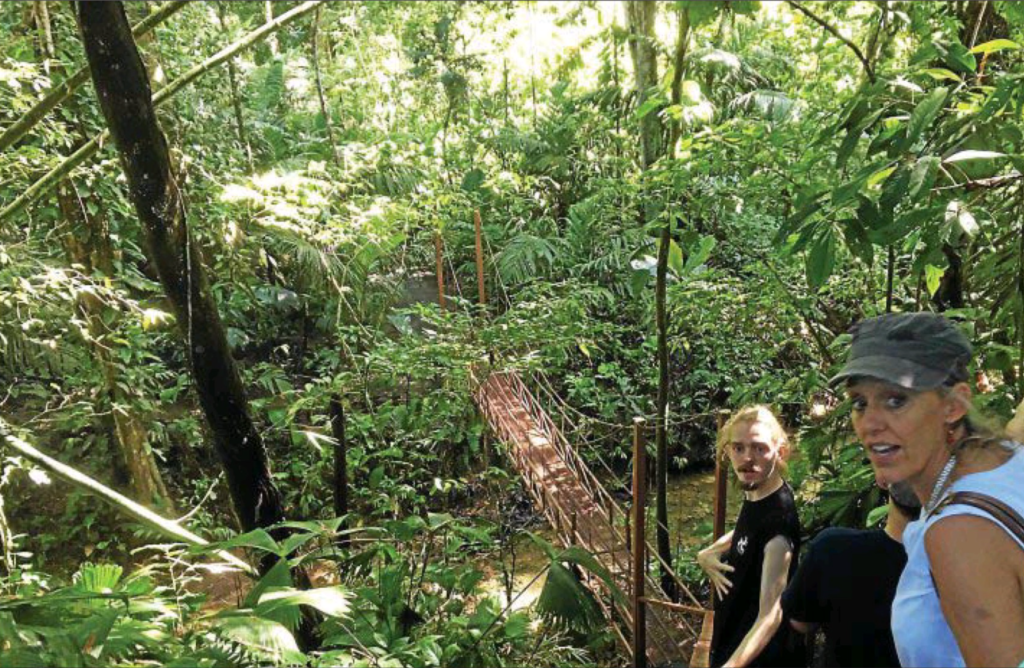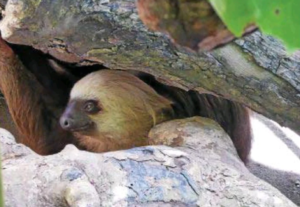Dedicated souls work to help animals
Not far from Puerto Viejo, dedicated souls work to help the jaguar and other creatures

Guide Devin Everaert leads a tour down into the rainforest, where they will cross a bridge and walk in the Costa Rican jungle to see what awaits.
(Janet Podolak)
The Jaguar Rescue Center and La Ceiba Private Reserve near Puerto Viejo was my long-awaited destination on Christmas Eve, two days before Holland America’s Zuiderdam would return me to its Fort Lauderdale home port.
I’d been to Costa Rica before, but never along this verdant Talamanca coast just 25 miles from the border with Panama. It’s almost always humid in this region, which gets up to 22 feet of rain a year and is lush with flowers and wildlife such as large cats, parrots, toucans and monkeys.
The Caribbean coast is more difficult to reach than the more touristy Pacific Coast. On the 90-minute shuttle ride from Puerto Limon, we saw a sparsely populated coast lined with vast palm-shaded beaches and a few settlements with no chain hotels, golf courses or restaurants. Opposite the beach, the rainforest comes almost to the sea.
Although it was clear and sunny on my December visit, the area’s abundant rain was apparent as we turned uphill to reach the rescue center. It quickly became obvious why we’d been told to wear closed-toe shoes as the steep and muddy so-called “road” required four-wheel drive to negotiate its unpaved and rutted surface into the rainforest. There, a blond, ponytailed young man waited next to a sign announcing the Jaguar Rescue Center.
He introduces himself as Devin Everaert from Minnesota and shows us a bristly black caterpillar hanging out on the rescue center sign with ominous-looking white bristles.
“This is a poisonous insect typical of what lives here,” he says. “You need to look where you walk and what you touch on today’s tour.”
This one will become a helliconia butterfly, but most caterpillars in this rainforest will inflict a nasty sting, he says.

This two-toed sloth appears to smile. Usually they’re found hanging high in the trees and difficult to see, this one hides in an area where she is being rehabilitated.
As we descend 30 steep wooden stairs to the forest floor, I carefully cling to the railing, watching where I grab. At the bottom we begin our walking tour among towering trees with chattering monkeys, reclusive sloths, complete with the distant scream of howler monkeys. It’s unlikely we’ll see a jaguar, Everaert tells us. Not only are they extremely shy of humans, they are very much endangered, with only about 1,400 remaining in the country.
“I’ve only seen them myself a few times,” he tells us.
The Jaguar Rescue Center is one of several places dedicated to their preservation.
He shows us a towering 80-foot tree he calls a walking palm, with its stilt-like roots above the ground and its smaller offspring in front of it with the same kind of roots. It’s one source of myths claiming the trees here walk at night. In reality, they allow the palm to remain stable and quickly grow upwards to reach the light above without needing to increase the diameter of the stem. Makes sense to me.
Costa Rica claims 4 percent of the world’s species, and many of them are found in the rainforest, we learn. Its dense canopy consists of hundreds of types of tall trees, which filter the sunlight and prevent heavy undergrowth on the forest floor. The rainforest is the oldest ecosystem in the world, and much of it in southern Costa Rica has never been cut, leaving trees with a 10-foot circumference.
Although it’s bright and sunny above the forest canopy, we walk in a treeshaded twilight among the trees, past a stream and a small pond with a waterfall. After being introduced to flora and fauna we probably wouldn’t have noticed without our guide, we’re led to a thatched shelter where a typical Costa Rican lunch is served.
Later, we go to the nearby Ceiba Rescue Center, where we meet Carlotta, a young woman so enamored of sloths that she came here from Italy to work to with them. Once we meet the cuddly looking creatures, several of us understand her passion.
“This isn’t a zoo,” she tells us, as we observe the cages. “It’s where we treat injured animals and help them recover so they can be released back into the wild.”
Large green macaws soar overhead and land on cages to observe us, and monkeys scamper among the trees. Howler monkeys in the distance mark their territories with loud, booming calls to warn other monkey groups away.
Electric lines are the biggest problems for sloths, Carlotta tells us.
“They look to animals like vines,” she says.
Once the animals have recovered, they’re micro-chipped before being released back into the wild.
Since beginning its work in 2008, the rescue center has rescued an average of 600 animals a year and returned 40 percent of them back into their natural habitat. It relies on a workforce of paid employees and volunteers, many of whom are young people working there for a gap year between high school graduation and college.



Recent Comments